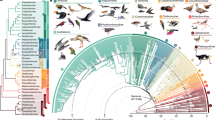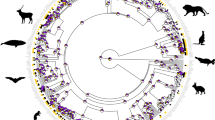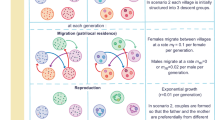Abstract
It has long been known that primate species differ greatly in the weight of their testes relative to body weight1. Recently it has been suggested that among the three species of Pongidae (the great apes), the disparity in testes weights is associated with their different breeding systems2–4. Male gorillas and orangutans copulate infrequently, and when a female comes into oestrus she normally mates with only one male. However, in the chimpanzee, several males mate frequently with the oestrous females, so that each male has to deposit enough sperm to compete with the presence of sperm from other males. For the chimpanzee, therefore, we hypothesize that selection will favour the male that can deposit the largest number of sperm; thus the volume of spermatogenic tissue and hence testis size is far greater in the chimpanzee than in the gorilla or orangutan. If this is correct, it implies that primates in which more than one male mates with each oestrous female should have larger testes relative to their body weight than those with single-male breeding systems. We have tested this prediction across a wide range of primates, and the results support the hypothesis. The relative size of testes may, therefore, provide a valuable clue to the breeding system of a primate species.
This is a preview of subscription content, access via your institution
Access options
Subscribe to this journal
Receive 51 print issues and online access
$199.00 per year
only $3.90 per issue
Buy this article
- Purchase on Springer Link
- Instant access to full article PDF
Prices may be subject to local taxes which are calculated during checkout
Similar content being viewed by others
References
Schultz, A. H. Anat. Rec. 72, 387–394 (1938).
Short, R. V. in Reproduction and Evolution (eds Calaby, J. H. & Tyndale-Biscoe, C. H.) (Australian Academy of Science, Canberra, 1977).
Short, R. V. Adv. Study Behav. 9, 131–158 (1979).
Short, R. V. in Reproductive Biology of the Great Apes (ed. Graham, C. E.) (Academic, New York, 1981).
Harcourt, A. H. in Reproductive Biology of the Great Apes (ed. Graham, C. E.) (Academic, New York, 1981).
Rijksen, H. D. A Fieldstudy on Sumatran Orang Utans (Veenman & Zonen, Wageningen, 1978).
Galdikas, B. M. F. in Reproductive Biology of the Great Apes (ed. Graham, C. E.) (Academic, New York, 1981).
Tutin, C. E. G. J. Reprod. Fert. Suppl. 28, 43–57 (1980).
Collins, A. New Scient. 78, 12–14 (1978).
Harvey, P. H. & Mace, G. M. in Current Problems in Sociobiology (ed. King's College Research Centre Sociobiology Project) (Cambridge University Press, in the press).
Brody, S. Bioenergetics and Growth (Reinhold, New York, 1945).
Amann, R. P., Johnson, L., Thompson, D. L. & Pickett, B. W. Biol. Reprod. 15, 586–592 (1976).
Amann, R. P. & Howards, S. S. J. Urol. 124, 211–215 (1980).
Ramakrishna, P. A. & Prasad, M. R. N. Folia primatol. 5, 176–189 (1967).
Moynihan, M. The New World Primates (Princeton University Press, New Jersey, 1976).
Dawson, G. A. & Dukelow, W. R. J. med. Primatol. 5, 266–275 (1976).
Moynihan, M. Smithson. Contr. Zool. 28, 1–77 (1970).
Middleton, C. C. & Rosal, J. Lab. Anim. 22, 583–586 (1972).
Baldwin, J. D. Folia primatol. 9, 281–314 (1968).
Kavanagh, M. & Dresdale, L. Primates 16, 285–294 (1975).
Hrdlicka, A. Am. J. phys. Anthrop. 8, 201–211 (1925).
Chivers, D. J. Folia primatol. 10, 48–102 (1969).
Kinsky, M. Anat. Anz. 108, 65–82 (1960).
Struhsaker, T. T. Behaviour 29, 83–121 (1967).
Kennard, M. A. & Willner, M. D. Endocrinology 28, 977–984 (1941).
Angst, W. in Primate Behavior. Developments in Field and Laboratory Research Vol. 4 (ed. Rosenblum, L. A.) (Academic, New York, 1975).
Simonds, P. E. in Primate Behavior. Field Studies of Monkeys and Apes (ed. DeVore, I.) (Holt, Rinehart & Winston, New York, 1965).
Southwick, C. H., Beg, M. A. & Siddiqi, M. R. in Primate Behavior. Field Studies of Monkeys and Apes (ed. DeVore, I.) (Holt, Rinehart & Winston, New York, 1965).
Roonwal, M. L. & Mohnot, S. M. Primates of South Asia (Harvard University Press, Massachusetts, 1977).
Kummer, H. Social Organisation of Hamadryas Baboons (University of Chicago Press, 1968).
Hausfater, G. Contr. Primatol. 7, 1–150 (1975).
Hall, K. R. L. & DeVore, I. in Primate Behavior. Field Studies of Monkeys and Apes (ed. DeVore, I.) (Holt, Rinehart & Winston, New York, 1965).
Hill, W. C. O. Primates. Comparative Anatomy and Taxonomy 8, Cynopithecinae (Edinburgh University Press, 1970).
Hall, K. R. L. Proc. zool. Soc. Lond. 139, 283–327 (1962).
Dunbar, R. I. M. & Nathan, M. F. Folia primatol. 17, 321–334 (1972).
Dunbar, R. I. M. & Dunbar, P. Contr. Primatol. 6 (1975).
Bernstein, I. S. Behaviour 32, 1–16 (1968).
Curtin, S. H. thesis, Univ. Calif., Berkeley (1976).
David, G. F. X. & Ramaswami, L. S. J. Morph. 135, 99–130 (1971).
Braz, I., Shandilya, L. N. & Ramaswami, L. S. Andrologia 8, 290–296 (1976).
Hrdy, S. B. The Langurs of Abu (Harvard University Press, Massachusetts, 1977).
Oates, J. F. Z. Tierpsychol. 45, 1–160 (1977).
Kawabe, M. & Mano, T. Primates 13, 213–227 (1972).
Chivers, D. J. in Primate Conservation (eds Prince Rainier III & Bourne, G. H.) (Academic, New York, 1977).
Kennard, M. A. & Willner, M. D. Endocrinology 28, 967–976 (1941).
Wislocki, G. B. J. Mammal. 23, 281–287 (1942).
Hall-Craggs, E. C. B. Proc. zool. Soc. Lond. 139, 511–514 (1962).
Benoit, J. C. r. Séanc Soc. Biol. 87, 1387–1390 (1922).
Daly, M. & Wilson, M. Sex, Evolution and Behavior (Duxbury, Massachusetts, 1978).
Author information
Authors and Affiliations
Rights and permissions
About this article
Cite this article
Harcourt, A., Harvey, P., Larson, S. et al. Testis weight, body weight and breeding system in primates. Nature 293, 55–57 (1981). https://doi.org/10.1038/293055a0
Received:
Accepted:
Issue Date:
DOI: https://doi.org/10.1038/293055a0
This article is cited by
-
Fiber counts and architecture of the human dorsal penile nerve
Scientific Reports (2023)
-
Female age and reproductive stage influence copulation patterns in mountain gorillas’ variable mating system
Behavioral Ecology and Sociobiology (2023)
-
Why People Keep an Intimate Relationship
Human Nature (2022)
-
Comparative analysis of sperm motility in liquid and seminal coagulum portions between Bornean orangutan (Pongo pygmaeus) and chimpanzee (Pan troglodytes)
Primates (2021)
-
Complex vocal learning and three-dimensional mating environments
Biology & Philosophy (2021)
Comments
By submitting a comment you agree to abide by our Terms and Community Guidelines. If you find something abusive or that does not comply with our terms or guidelines please flag it as inappropriate.



